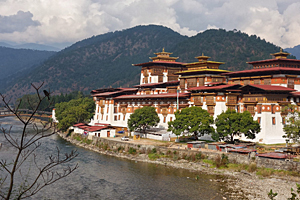If you’d like to inquire about a post-tour or book one of the options, please contact A Noble Traveller at [email protected]
A Journey to Central Bhutan
Central Bhutan is an exciting destination for all visitors. It includes some of the most significant historical and religious sites in the country. The district of Trongsa has always been of great political importance to the leaders of Bhutan, due to its commanding location in the center of the nation, while Bumthang district has some of the most ancient and important monasteries in Bhutan.

Important Landmarks in Central Bhutan
- Kurje Lhakhang— built in 1652 at the site where the great Buddhist saint Guru Rimpoche meditated
- Tamshing Lhakhang— the great religious site that revealer Terton Pema Lingpa built in 1501
- Mebar Tsho— a sacred lake from which Terton Pema Lingpa discovered religious treasures hidden by Guru Rimpoche
- The Watchtower of Trongsa Museum— This ancient tower has been made into a museum dedicated to the Wangchuck dynasty and provides visitors with unparalleled insight into Bhutan’s political history.
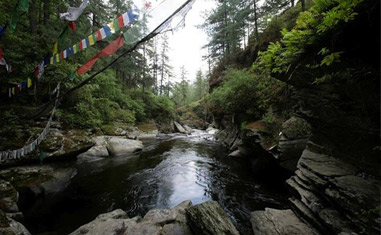
MEBAR TSHO – (The Burning Lake) According to the legend, Terton Pema Lingpa had a vision of sacred treasures that Guru Rimpoche had hidden within the lake centuries earlier. However, the people of Tang and the local ruler were cynical of his claims. In order to prove his claims, Pema Lingpa held a butter lamp in his hand as he jumped into the lake. After remaining underwater for a long time, he re-emerged holding a chest and a scroll of paper with the butter lamp held in his hand still burning bright. Thereafter, the lake came to be known as Mebartsho (the burning Lake).
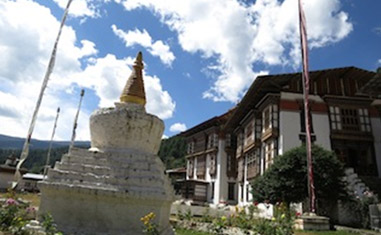
KURJE MONASTERY: Located further along the valley, Kurje Lhakhang is comprised of three temples. The one on the right was built in 1652 against the rock face where Guru Padmasambhava meditated in the 8th century. The middle temple is built on the site of a cave containing a rock with the imprint of the Guru’s body, and is therefore considered to be the most holy. The temple on the left was built in the 1990s by H.M. Ashi Kesang, the Queen Mother. These three temples are surrounded by a 108 Chorten wall.
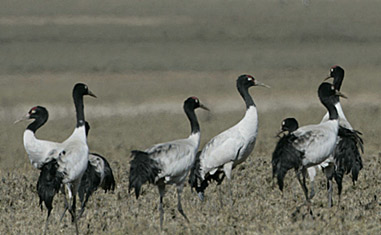
BLACK-NECKED CRANES AND THE PHOBJIKHA VALLEY: Nestled in the inner Himalayas at about 9842 feet above sea level, Phobjikha is a wide alpine wetland valley that is the largest and most significant wetland in the country. The valley’s inhabitants live harmoniously with nature, and the valley also holds great cultural significance. The majority of the country’s endangered Black‐necked cranes winter here, leading this area to be protected by Bhutan since time immemorial by the local people’s traditional respect for all living beings. Adding to the valley’s stunning beauty is the highly revered Gangtey monastery that overlooks the wetlands surrounded by subsistence farms and natural forest areas.
Saturday, December 13th: Paro – Bumthang on Druk Air KB1001. Departs at 11:30 and Arrives 12:05. After arriving you will drive to your hotel and rest. Begin exploring the valleys of Bumthang (Choekhor, Tang, Ura and Chume) over the next couple of days. While your schedule is flexible, we suggest you start by visiting Tamshing Lhakang, a temple built by the Buddhist Saint Pema Lingpa, which contains some of the oldest wall paintings in Bhutan. You can continue your exploration of Bumthang by visiting Jambe Lhakang, built in the 7th century by King Srongtsen Gampo of Tibet, one of the oldest temples in Bhutan. You will continue down the valley to Kurje Lhakhang, a 17th Century temple that is part of a complex of temples of great historical importance. This Lhakhang holds the imprint of Guru Rinpoche, the revered Buddhist saint who brought Buddhism to Bhutan and much of the Himalayas. After your visit to Kurje you will return to the hotel for the evening. (Overnight at Swiss Guest House).
Sunday, December 14th: Explore Bumthang. Visit to the Wangduechhoeling Palace, built by Jigme Namgyal and used by his son, Ugyen Wangchuck, the first king of Bhutan, as his principal residence. After visiting the Palace you will visit Jakar Dzong in the Jakar Dzong is one of the largest and most impressive dzongs in Bhutan and houses the administrative and monastic offices for the Bumthang district. You will then continue up the valley to visit the Ugyen Wangchuck Institute for Conservation and the Environment (UWICE), which is considered the premier institute for research and training in forestry and environmental science for Bhutan and the Asian region. (Overnight at Swiss Guest House).
Monday, December 15th: Explore Tang Valley. You will spend the day visiting the Tang Valley, starting with a short hike to Mebartsho (The Burning Lake). Legend says that this is the site where Pema Lingpa, one of Bhutan’s most revered saints and Tertons (Discoverers of Hidden Treasures), dove into the lake with a lighted lamp, only to emerge back with the lamp still burning and holding a statue and a chest containing sacred Buddhist texts. You will then continue up the valley for lunch at the Ugyen Chhholing Palace, now converted into a museum which houses permanent exhibits on three floors of the main building. Traditional living quarters are recreated to capture the realistic ambiance of the ancient lifestyles and conditions of the households. Everyday kitchen and weaving utensils, war weapons–including petrified yak dung to make gunpowder–tools and farming implements are featured in the exhibits. (Overnight at Ogyen Choling Guest House, Tang).
Monday, December 16th: Bumthang – Phobjikha (9,800 ft). Drive back down the valley, stopping at Pema Choling Nunnery for a visit and prayers before returning to Jakar and your journey back to western Bhutan. Soak in the scenery on this five-hour drive to the Phobjikha Valley, one of the most magical valleys in all of Bhutan. You will stop along the way to visit the restored Ta Dzong at Trongsa, which has been made into a museum covering the history of the monarchy of Bhutan. After lunch, you will drive for 2 hours to Phobjikha crossing Pele La Pass (11,250 feet) where on a clear day you can see Mt. Jhomolhari, Jichu Drakye and Kang Bum, three of Bhutan’s prominent peaks. (Overnight at Yue-Loki Guest House).
Tuesday, December 17th: Phobjikha – Punakha (4,200 ft). During the winter, the Phobjikha Valley is home to more than 300 endangered black-necked cranes. They begin arriving at the end of October and leave mid February. You can start the day by visiting the Gantey Gompa (monastery) founded in 1613. The current Gantey Tulku is the 9th reincarnation of Pema Lingpa, the famous Buddhist saint from whom the Royal Family is descended. After visiting Gantey, there is a lovely walk down through the valley known for sightings of the black-necked cranes. Depart Phobjikha late in the afternoon, crossing Lawa La pass and then descending into the Punakha Valley. (Overnight at Dragon’s Nest Hotel).
Wednesday, December 18th: Punakha – Paro. Explore Punakha Valley in the morning. Depart for Paro after lunch in Thimphu. The drive from Punakha to Paro is about 3.5 hours. Enroute, you will go over the Dochula Pass (10,100feet) – for breathtaking views of the Bhutanese Himalayan range. (Overnight at Jankha Hotel).
Thursday, December 19th: Depart Paro to Bangkok on Druk Air KB122 at 11:00 and arrive Bangkok at 16:40
Cost per person: US$1,575 (Maximum group size 20, minimum group size 3)
- Druk Air Domestic Flight from Paro – Bumthang
- Airport transfers and ground transport
- Experienced Bhutan Tourism certified Guide & Driver
- Accommodation and meals at standard 3 Star hotels (sharing).
- All meals at local restaurants
- Tips to guide and driver
Not included in the price:
- Meals at luxury hotels not listed in the itinerary
- Miscellaneous expenses: Soft drinks, alcoholic beverages, laundry, intl. calls, spa, etc.
- Change in itinerary due to events beyond our control such as change/cancellation in flights etc.
- Single rooms (US$50) additional per night.
The Druk Path Trek
The Druk Path Trek is the most popular trek in the country as it passes through a gorgeous natural landscape of blue pine forests, high ridges and pristine lakes, while at the same time offering the opportunity to visit some ancient lhakhangs, dzongs and villages. The trek follows the original ancient mule track that once connected Bhutan to the Indian border. The Druk Path is also a fairly easy hike to undertake, as the distances between rest camps are fairly short. The trail takes you through forests of fir, blue pine and dwarf rhododendrons at altitudes ranging between 7,874 -13,779 feet. On the third day, you will arrive at Jigmelang Tsho Lake, whose crystal clear waters are home to gigantic trout. This trek also offers stunning views of Mt. Gangkar Puensum (24,836 ft.), the highest unscaled peak in the world.

Saturday, December 13: Paro – Jili Dzong (Druk Path Trek begins).
- Distance: 4.5 miles
- Time: 4-5 hours
- Camp Altitude: 11,417 feet
After breakfast we depart for the open meadows slightly above Paro Ta Dzong, where you will be greeted by our Trekking staff and begin the Druk Path Trek. You will hike along the original mule track that once connected Bhutan to the Indian border. Ponies will carry your trek bags as you wind slowly and evenly upward, enjoying the views below of the Paro Valley. Tonight you camp in a clearing a few hundred feet below Jili Dzong monastery. (Overnight Tent).
Sunday, December 14: Jili Dzong – Jangchulakha.
- Distance 6.5 miles
- Time: 4-5 hours
- Camp Altitude: 12,368 feet
An early visit to the Jili Dzong monastery reveals haunting stories and a large statue of Buddhist teacher and philosopher, Padma Sambhava. You begin with a steep climb for about an hour and a half, then the slope evens a bit and the ascent is more gradual. The trail takes you through thick alpine forests and dwarf rhododendron tress. Weather permitting, you will have fine views of Mt. Jhomolhari and other snow capped peaks – one may also hear some monal pheasants calling during the day. You may see herders and their yaks around your campsite. (Overnight Tent).
Monday, December 15: Jangchulakha – Jigmelang Tsho.
- Distance: 7 miles
- Time: 4 hours
- Camp Altitude: 12,696 feet
The trail follows a ridge and on a clear day the view of the mountains and valley are simply stunning. Look out for great views of Jichu Drake (22,930 feet), the peak representing the protective deity of Paro. The campsite is close to the Jimgelang Tsho Lake. This lake is known for its giant sized trout. (Overnight Tent).
Tuesday, December 16: Jimgelang Tsho – Simkotra Tsho.
- Distance: 7 miles
- Time: 4 hours
- Camp Altitude: 13,484 feet
The trail takes you through dwarf rhododendron trees and past Janetso Lake. You may come across some yak herder camps where you will have the opportunity to get a glimpse of a nomad’s life. The campsite is close to Simkotra Tsho Lake. (Overnight Tent).
Wednesday, December 17: Simkotra Tsho – Phajoding – Thimphu.
- Distance: 8.5 miles
- Time: 6 hours
The day begins with a gradual climb. If the weather permits, you will have a spectacular view of Mount Gangkar Puensum, the highest mountain in Bhutan and several other Himalayan peaks. From this pass, the trek takes you downhill towards Phajodhing Monastery – where you will have a picnic lunch. Phajodhing Monastery was once one of the richest and most decorated monasteries in the country however due to years of neglect and the encroachment of development, it was watch listed in 2010 by the World Monuments Fund as one of five endangered cultural monuments that need most help in the world. After lunch, you will visit the monastery and then descend gradually to Thimphu, where you will say goodbye to your trekking team. Your cultural guide and driver will be there to receive you. (Overnight Galingkha Hotel)
Thursday, December 18: Depart for Bangkok on Druk Air KB126: 11:45 – 16:45.
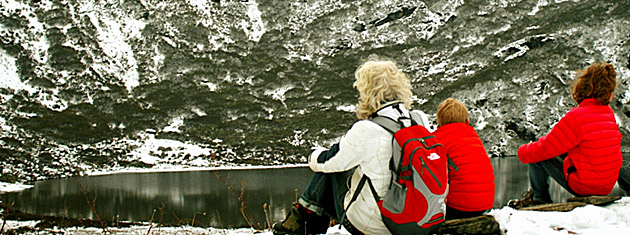
Cost per person: US$1,300 (Maximum group size 15, minimum group size 4)
- Full trekking services: Guide, Cooks, Tenting Staff, Horses and Supplies
- All trekking equipment (except sleeping bags)
- Tips to guide and staff on trek
- Overnight at Galingkha Hotel, Thimphu
- All meals on Trek and at Galingkha Hotel
- Room/Tent sharing
- Single room/single tent fee is US$50 additional per night
- Transport and Transfer to Airport

